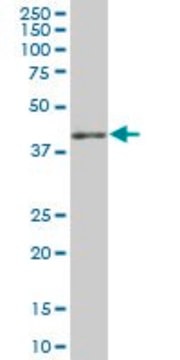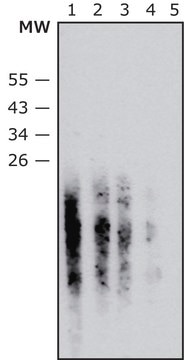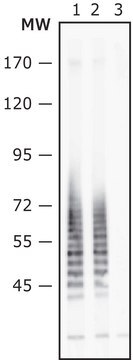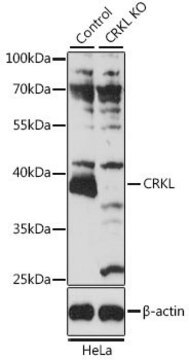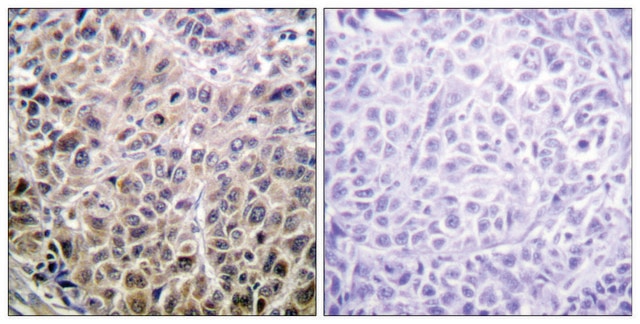SAB4700300
Monoclonal Anti-HLA-E antibody produced in mouse
clone MEM-E/08, purified immunoglobulin, buffered aqueous solution
Sign Into View Organizational & Contract Pricing
All Photos(1)
About This Item
UNSPSC Code:
12352203
NACRES:
NA.41
Recommended Products
biological source
mouse
Quality Level
conjugate
unconjugated
antibody form
purified immunoglobulin
antibody product type
primary antibodies
clone
MEM-E/08, monoclonal
form
buffered aqueous solution
species reactivity
human
concentration
1 mg/mL
technique(s)
flow cytometry: suitable
isotype
IgG1
NCBI accession no.
UniProt accession no.
shipped in
wet ice
storage temp.
2-8°C
target post-translational modification
unmodified
Gene Information
human ... HLA-E(3133)
Related Categories
General description
The antibody MEM-E/08 recognized native surface-expressed HLA-E, but not denaturated heavy chain of HLA-E. HLA-E belongs to the MHC Class I molecules (MHC Class Ib; nonclassical) and it is expressed on many types of the human cells. The published results revealed that antibody is remarkably specific for HLA-E, only with weak cross-reactivity with following classical MHC Class I molecules (MHC Class Ia): HLA-A24, -B7, -B27, -B51, -B54, -C7.
Immunogen
Bacterially expressed recombinant HLA-E refolded with beta2-microglobulin and peptide
Application
The reagent is designed for Flow Cytometry analysis. Suggested working dilution for Flow Cytometry is 4 μg/mL of sample. Indicated dilution is recommended starting point for use of this product. Working concentrations should be determined by the investigator.
Features and Benefits
Evaluate our antibodies with complete peace of mind. If the antibody does not perform in your application, we will issue a full credit or replacement antibody. Learn more.
Physical form
Solution in phosphate buffered saline, pH 7.4, with 15 mM sodium azide.
Not finding the right product?
Try our Product Selector Tool.
flash_point_f
Not applicable
flash_point_c
Not applicable
Certificates of Analysis (COA)
Search for Certificates of Analysis (COA) by entering the products Lot/Batch Number. Lot and Batch Numbers can be found on a product’s label following the words ‘Lot’ or ‘Batch’.
Already Own This Product?
Find documentation for the products that you have recently purchased in the Document Library.
Tsufit Gonen-Gross et al.
Journal of immunology (Baltimore, Md. : 1950), 175(8), 4866-4874 (2005-10-08)
For a proper development of the placenta, maternal NK cells should not attack the fetal extravillous cytotrophoblast cells. This inhibition of maternal NK cells is partially mediated via the nonclassical MHC class I molecule HLA-G. Recently, we demonstrated that HLA-G
Damien M Callahan et al.
Journal of applied physiology (Bethesda, Md. : 1985), 116(12), 1582-1592 (2014-05-03)
Age-related loss of skeletal muscle mass and function is implicated in the development of disease and physical disability. However, little is known about how age affects skeletal muscle structure at the cellular and ultrastructural levels or how such alterations impact
Jia Qi et al.
Biological & pharmaceutical bulletin, 37(11), 1713-1718 (2014-11-05)
Heat shock protein 90 (HSP90) is a ubiquitous molecular chaperone involved in the proper conformation of many proteins. HSP90 inhibitors (17-dimethyl aminoethylamino-17-demethoxygeldanamycin hydrochloride [17-DMAG]) bind to and inactivate HSP90, suppressing some key signaling pathways involved in the inflammatory process. Since
Lasse Gliemann et al.
American journal of physiology. Heart and circulatory physiology, 307(8), H1111-H1119 (2014-08-17)
In animal studies, the polyphenol resveratrol has been shown to influence several pathways of importance for angiogenesis in skeletal muscle. The aim of the present study was to examine the angiogenic effect of resveratrol supplementation with parallel exercise training in
Mari Narumi et al.
PloS one, 9(10), e109859-e109859 (2014-10-10)
Compared with the peripheral corneal limbus, the human central cornea lacks blood vessels, which is responsible for its immunologically privileged status and high transparency. Dendritic cells (DCs) are present in the central avascular area of inflamed corneas, but the mechanisms
Our team of scientists has experience in all areas of research including Life Science, Material Science, Chemical Synthesis, Chromatography, Analytical and many others.
Contact Technical Service
